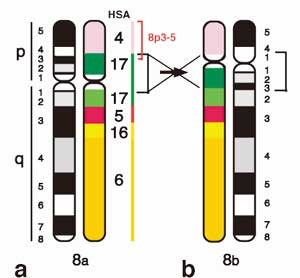The first finding of chromosome variations in wild-born western hoolock gibbonsIsrat Jahan、平井百合子、Zahed Mohammad Malequr Rahman, Md Anwarul Islam, 平井啓久 シロマユテナガザル類(Hoolock属)は絶滅危惧種に指定されるテナガザル類です。バングラデシュでの生息個体数は約350個体と推定されています。そのため保全計画が喫緊の課題です。保全計画には遺伝的情報が非常に重要です。今回、バングラデシュの森林で捕獲された西シロマユテナガザル2個体の染色体を解析し、2種類の染色体変異が見つかりました。バンド解析や染色体彩色解析から、その第1は第8染色体で見つかった挟動原体逆位で、第2は核小体形成部位の増幅変異であることが明らかになりました。これらの染色体変異は将来の保全計画や進化解析において重要な情報となることでしょう。 Primates DOI 10.1007/s10329-013-0382-2 http://www.springerlink.com/openurl.asp?genre=article&id=doi:10.1007/s10329-013-0382-2 
Hoolock gibbons (genus Hoolock) are a group of very endangered primate species that belong to the small ape family (family Hylobatidae). The entire population that is distributed in the northeast and southeast of Bangladesh is estimated to include only around 350 individuals. A conservation program is thus necessary as soon as possible. Genetic markers are significant tools for planning such programs. In this study, we examined chromosomal characteristics of two western hoolock gibbons that were captured in a Bangladesh forest. During chromosome analysis, we encountered two chromosome variations that were observed for the first time in the wild-born western hoolock gibbons (Hoolock hoolock). The first one was a nonhomologous centromere position in chromosome 8 that was observed in the two examined individuals. The alteration was identical in the two individuals, which were examined by G-band and DAPI-band analyses. Chromosome paint analyses revealed that the difference in the centromere position was due to a single small pericentric inversion. The second variation was a heterozygous elongation in chromosome 9. Analysis by sequential techniques of fluorescence in situ hybridization with 18S rDNA and silver nitrate staining revealed a single and an inverted tandem duplication, respectively, of the nucleolus organizer region in two individuals. These chromosome variations provide useful information for the next steps to consider the evolution and conservation of the hoolock gibbon.
AUG/26/2013
Copyright(C) 2012 PRI ( ). ).
| 






